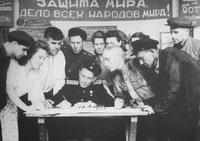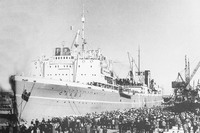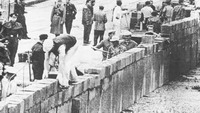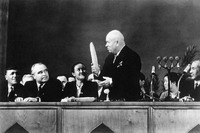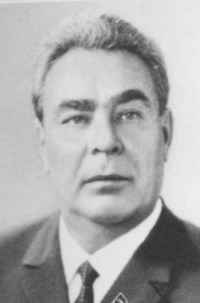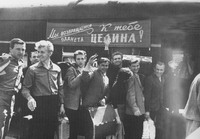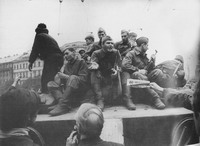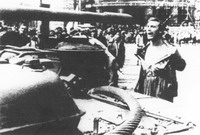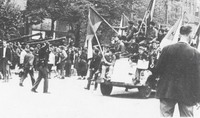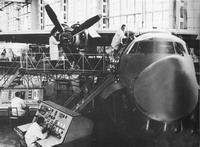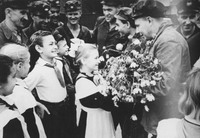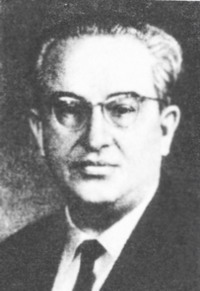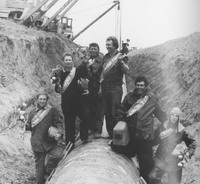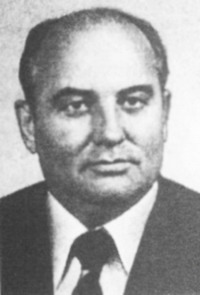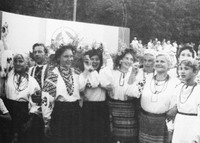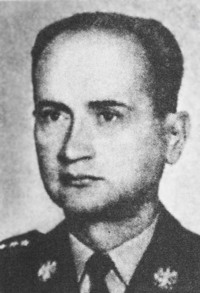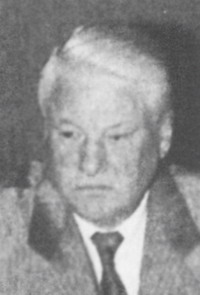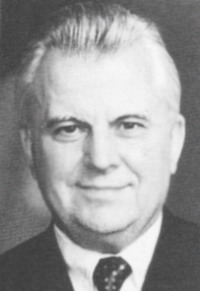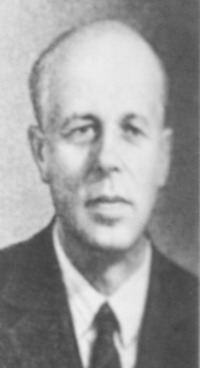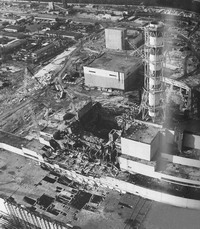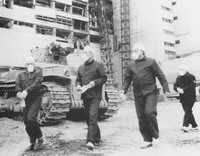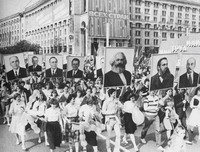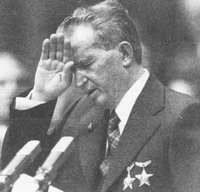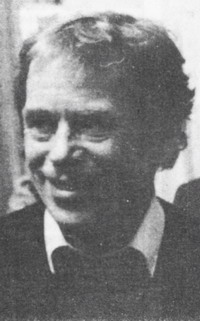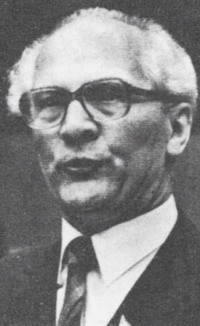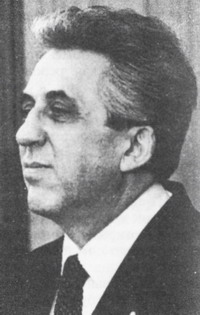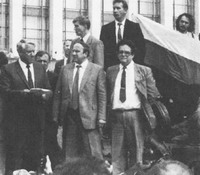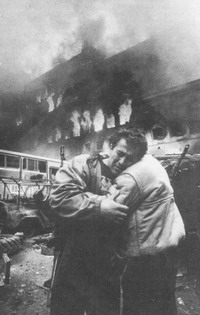USSR. Restored and Newly IndependentState
§ 18. USSR in the second half of the 40's -early 60 th century.

1. The consequences of World War II for the USSR. ReconstructionEconomy
Victory in World War II ledto fundamental changes in Soviet international position. The Soviet Union left theWar superpower in the new quality.
There were significant territorial changes(The only state in which the war has made significant territorialacquisition). However, the price gained new status was too high.
|
Human loss
|
27 million people. Some researchers give much higher figures - More than 40 million people.
|
|
Losses
|
One third of the national wealth. 1710 cities, 70 thousand villages, 32 thousand 100 thousand industrial and agricultural enterprises, 1135 mines, 65 thousand km of railways, locomotives 16 thousand, 428 thousand railway cars etc..
|
|
Territorial changes
|
- Fixed joining Western Ukraine and Western Belarus, Bessarabia, Northern Bukovina, the Baltic States, Finland, accomplished within the 1939-1940 biennium; border with Poland was finally agreed in 1951;
- In 1944 to the Soviet Union joined Tuvynska People Republic;
- The contract in 1945 from Czechoslovakia to the USSR Carpatho-Ukraine was added;
- At the Potsdam Conference to the Soviet Union went Prussian city of Koenigsberg and (from 1946 - Kaliningrad) with the adjacent territory;
- The peace treaty with Finland admitted borders 1940 and went to the USSR region Petsamo (Pechenga) and some other Borderlands;
- After the defeat of Japan to the USSR went South Sakhalin and the Kuril Islands, Port Arthur.
|
|
Socioeconomic Impact
|
Significant and so little living standards. Wages remained at 1940 prices increased 3 times. To 1947 kept card system.
25 million were left homeless. Children homelessness. Problems of placement of demobilized from the army - 8,5 million people. those who returned from captivity and forced labor - more than 5 million people. A new wave of deportations from the western regions of the USSR.
Significant loss of the working population. Lack of labor force.
Industrial production in the regions that suffered occupation constituted about 30% of the war. But during the war created a new industrial base in the East.
Agricultural output amounted to 60% war. Grain production fell by 2 / 3.
|
|
Political changes
|
Patriotic enthusiasm, expectations for changes in population political and economic sphere. Restoration and strengthening of repression, the new providing the ideological (a combination of Russian nationalism, anti-Semitism and chauvinism
Marxism-Leninism). Combating anti-Soviet rebel movement in western regions of the USSR (Ukraine, Belarus, Baltic countries).
|
Rebuilding started immediately afterthe liberation of occupied territories. Thereafter, for its holding was developedfourth five-year plan (1946-1950).

Women inrehabilitation of the Dnipro. Kiev, 1947
The country faced the question ofways of economic development and again as before the war, Stalin put forwardslogan: complete the construction of socialism and begin the transition to communism. In his view,war only delayed the task. Stalin assumed thatbuilding material and technical base of communism is enough to bring the productioniron to 60 million tons per year of steel - up to 60 million tons, oil - to 60 milliontons, coal 500 million tons this way priority was placedreconstruction and development of the industry group "A". To implement this taskIV was developed five yatyrichnyy Plan (1946-1950).
Rebuilding the economy (1943-1951 biennium)
|
Reconstruction Activities
|
|
Cancel wartime restrictions
|
Measures to raising living standards. Currency reform
|
Measures for Restoration Industry
|
Measures Agriculture
|
|
Restoration 8 th working day and holiday;
Cancel compulsory nadurochnih works;
Revocation Laws and wartime restrictions.
|
Employment demobilized and repatriated.
Cancel card system (1947);
Reduced prices food and industrial products;
Deployment housing;
Increase production of consumer goods;
Currency reform (1947).
|
Partial transfers of undertakings on the issue of peaceful production;
Restoration destroyed industrial facilities, especially heavy industry;
Development energy;
Introduction new techniques and technologies;
Construction of new enterprises.
|
Restoration MTS supplies agricultural village;
Raising standards grain reserves, increasing taxes;
Forced loans;
Orhnabory rural youth in the reconstruction of cities and industry.
|
For large-scalereconstruction program in addition to the required deadlines were considerable materialand financial resources. But after such a destructive and bloody war, they were obviouslylimited. Therefore, their concentration used in any action. YesThe following could be the main source of reconstruction.
|
1. Profits of existing businesses. Redistribution of resources of light and food in favor of heavy industry.
|
|
2. Labor enthusiasm. Motion makers.
|
|
3. The monetary reform in 1947
|
|
4. Collectivization in the western regions of the USSR. "Dispossession".
|
|
5. Forcing people to save and its withdrawal (bonds, lotteries).
|
|
6. Sales abroad of national cultural values.
|
|
7. Antireligious campaign in the western regions of the USSR. Liquidation Church. Robbery churches.
|
|
8. Increase to standards while maintaining the prewar wages.
|
|
9. Increased exports of raw materials and agricultural products abroad.
|
|
10. The employment of prisoners in the Gulag (8-9 million people.) Prisoners of war and (Germans - 1,5 million Japanese - 0,5 million).
|
|
11. Increased direct and indirect taxes, particularly on farmers.
|
|
12. The existence of the card distribution system of products and toiletries need to 1947 Reduced standards of living.
|
|
13. Reparations from Germany (4.3 billion dollars.), Italy, Hungary, Romania and Finland. In general, equipment was taken out of Europe 4293 enterprises.
|
Features vidbudovchoho period:
1.
Large scale vidbudovchyh works, more thanin any other country in Europe;
2.
Calculation
only on its own forces, not foreign aid. The Cold Warmade possible the use of Western, primarily American, financialand technical assistance;
3.
When rebuilding stake on the so heavyIndustry and Energy (88% of investment) due to lightindustry, social services and agriculture (the lastassigned only 7% of capital);
4.
Reconstruction was performed centrally bya clear government plan;
5.
A large part of the administrative-commandsystem. She made it possible for a short mobilize and concentrate significantmaterial and human resources at some objects yekti;
6.
Disproportionately large role of ideology whichfound its expression in large-scale mobilization and propaganda activities- Socialist competition and movement makers
innovators;
7.
Complications process of drought and famineOf 1946-1947 In a country starved of both the Soviet leadership has soldabroad 1.5 million tons of grain;
8.
Manpower shortage, especiallyefficient, modern equipment, and technology.
9.
Strengthening of the Stalinist regime.
Results vidbudovchoho periodambiguous. On the one hand was healed wounds of war, rebuilt Industryin 1946-1950 he was even increased production. However, volumeProduction of light industry in 1950 constituted only 80% of the war. Fromother hand the reconstruction cost was very high. Decline in real living standards,severe housing and living conditions were typical for the majority.
Derationingdistribution of food and monetary reform in 1947 in a largerAs translated the burden on the shoulders of working people reconstruction.

On the field of farm"October"-Podilski region. 1946
Another negative consequence wasthe final ruin of agriculture. At the farmers who received scantyEarnings, not spread social security, they were denied the right to havepassport, and therefore move freely. But they also had to payhigh taxes that were imposed on private households. To intensifylabor in kolkhoz Stalinist leadership continued to usecoercive and repressive methods.
Despite repression, extremeefforts of the villagers at the end of five yatyrichky never managed to achieve performancepre-war development. So in 1950 grain yield was only 85%war.

Convoy of breadheading to the elevator. Odessa regions, 1947

2. Socio-political life 1945-1953 biennium
With the end of the war the population of the USSRfostered the hope that the country nastuplyat changes. Workers had hoped to be liftedsevere pre-judgments, which are dragged by a criminal liability for20-minute delay. The peasants dreaming of improving their lives. Hopesrelease to go back home to millions of cherished Gulag prisoners.

Lawrence Beria -one of the most active organizers of mass repressions
As a result of war, many citizenslost family members, particularly affected the children. The country has increased dramaticallyhomelessness. A serious problem was the criminal crime, especiallythat remained in the hands of many weapons.
Immediately after the warbegan the demobilization of armed forces at that time numbered 11 365 ths.
Most need a lot of demobilizedwas to employ a professional resume and employment skills lost during theWar.
At home be turned significantnumber of immigrants (by years of war in Germany were deported for forcedof 2.8 million people., were taken prisoner more than 4 million people.). All of them hadgo through Stalin's repressive suspicion, mistrust, misunderstanding.With 800 thousand prisoners who returned home, half gotto the gulag. August 16, 1941 order was issued, under which commanders andpolitical instructors that they were in captivity, are considered deserters and their families bearrest and Family Red deprived of state aid. Yes1950 generals were executed PG Ponedyelin and MK Kirillov, who were incaptivity.
In addition, the Stalinist leadershiphad to suppress the movement in western Ukraine, western Belarus, the Baltics, wheremilitias (UPA, "Forest Brothers", etc..) fought forindependence of Ukraine, the Baltic republics, Sovietization against these regions.Regions were mass deportations: in Western Ukraine were deported 300ths., Baltic 400 thousand Lithuanians, Latvians 150 thousand, 50 thousandEstonians.
During the war, were heldbrutal punitive operation against entire nations. Even at its beginning waseliminated the Volga German Autonomous Republic. 300 thousand people. wasdeported to distant regions of Siberia and Kazakhstan. Similar events in 1943were committed against Kalmyks in 1944 against Karachayevs, ChechensIngush Balkars, Crimean Tatars. Named people forcibly removed insparsely populated areas of Siberia, Kazakhstan and Central Asia. These excesses of Stalinismbecame known in 1956 when N. Khrushchev put it in his"Secret report" at the XX Party Congress. It particular, it notedand this: "Ukrainians were deprived of participation just because they weretoo much and there was no place where they are evicted.
Growing number of political prisoners(Prisoners of war, leaders of national liberation movements, etc.) resulted inGulag uprisings in the camps under political slogans. The most famous of themwere the performances in Pechora (1948), Salekhard (1950), Kinhiri (1952),Ekibastuz (1952), Vorkuta (1953), Norilsk (1953). Forsuppression of certain statements even had to use tanks.
After the war Stalin began againfear strengthening the military. K. Rokossovsky was sent to Poland toas Minister of National Defence. Was arrested by MarshalA. Novikov. Against G. Zhukov was preparing litigation. Begun arrestssoldiers who were in close relationship with Zhukov. The process against Zhukovstopped Stalin himself, stating, "Zhukov will not go against the CC.
Your Stalinregime in the postwar period (1945-1953 biennium)
|
1.
Consolidation of power Stalin as a result of victory in war.
|
|
2.
Further centralization government, swelling the state apparatus. Offsetting any independence on the ground.
|
|
3.
Increase representation in the councils of the party-state nomenclature.
|
|
4.
Repression against prisoners of war and repatriated. Increased repression: "Leningrad affair, "the right doctors, fighting cosmopolitanism, repression war.
|
|
5.
Strengthening ideological press. "Zhdanivschyna.
|
Stalin began to attack the system andon the ideological front. The former glory of Russia became one of Stalin's evidencein favor of continuity of his regime against the Russian Empire.Ideology and political practice of Stalinism has openly the Greatnationalist Fig. Proclaimed everywhere that the economy andpolitics, philosophy and science is the Russian idea has "world-historicalvalue. The Russian people, according to Stalin, which were presented atbanquet in honor of the victory over fascism "in this war deserve the totalrecognition as a guiding force of the Soviet Union among all the peoples of ourcountry. The Russian people proclaimed as the most advanced in terms ofculture and economic development.
Stalin's toast at the reception in the Kremlin in honor of the commandersRed Army troops May 24, 1945
"Comrades Let me meThe last one eschё raise a toast. I, I would like to raise goblet Healthier for the Soviet people of ourand, above all, russkoho people.
I pyu, above all, byHealthier russkoho people later on that the most yavlyaetsya vыdayuscheysya nation fromall the nation, members of the Union of Soviet composition.
I podnymayu goblet Healthier people russkoho for laterOn that war is won in эtoy OVERALL recognition, as the forces of the Soviet rukovodyascheyUnion among all the peoples of our country.
I podnymayu goblet Healthier russkoho for people not onlylater, that he - rukovodyaschyy people, but also later, that in him ymeetsya yasnыy mind,stands the nature and patience.
In the government of ourit was a lot of mistakes, was a moment of despair, we Guideline in 1941-1942 hodah,when our army otstupala have left us rodnыe village and the city of Ukraine,Belarus, Moldavyy, Leningrad region, the Baltic States, Karel V-иnskoy republic, left, because no it was's choice. Natalia Ynoy people would sayGovernment: "You are not justified our ozhydanyy aside other things, we setAnother government, which was to conclude peace with Germany and ensure quiet of us. "But russkyy went to the people not on this is, ybo veryl on the correctness of his policyGovernment and poshel on zhertvы, When obespechyt razhrom Germany. And that isof confidence russkoho Soviet people that the Government okazalos reshayuschey forcekotoraya obespechyla ystorycheskuyu victory over Vragi mankind - over fascism.
Thanks emu, preambularpeople, for this is of confidence.
For Healthier russkohopeople! "
Summer 1946 startedbroad offensive on the ideological "front", called"Zhdanovschyna. The beginning was its ruling CPSU (B) on Magazines"Zvezda" and "Leningrad", was initiated by Stalin, andthe main driver - Zhdanov, Politburo member and secretary of CPSU (B).The main goals of the company for elaboration was chosen AA Akhmatovaand M. Zoshchenko.
The decree of the literature were addedResolution on the repertoire of drama, the movie is "greatlife, "an opera about Mr. Muradeli" great friendship ".
Established practice closure journalsprohibition of literary, musical and cinematographic works.
Again began to attack"Formalist" in music, including major named S. Prokofievand Dmitry Shostakovich.
At the same time The fight against"Cosmopolitanism" in which Jewish representatives accusedintellectuals .. In this "ment" fighting killed famous figuresculture: an actor and director S. Mihoels, poet P. Marques et al. This campaign is significantextent wore anti-Semitic connotation. However cosmopolitan to announceany person who is an interest in Western literature, music and painting. Itled to the isolation of the Soviet people from the achievements of world culture.
The existing system of management scienceput loyalty above all scientific dogmatism, which Stalin set out in the "Short CourseHistory of the CPSU (b), virtually excludes any expression of free research. Andand structure of academic staff was not homogeneous. Along with scientists,who have made outstanding contribution to world and national science, such asPL Kapitsa, SI Vavilov, Keldysh, there were many careerists and false doctrines.
After his arrest on the eve of war andthen the tragic death of NI Vavilov, a leading place in biology tookTD Lysenko and his followers.
Vigorous, energetic, masterintriguant T. Lysenko continuously swore fidelity to Marxism-Leninism and personallyStalin gave a promise to bring high-yielding varieties and resolve foodproblem. But in the way of his "scientific" activities wereGenetics, who argued the absurdity of his statements. With the support ofStalin, Lysenko went on the offensive.
In August 1948 wassession-Union Academy of Agricultural Studies. Lenin(VASHNIL). Lysenko made it to the report. He said that the report isapproved the CPSU (B), and, therefore, Stalin personally. These scientists are not lostscientific beliefs (VS Nemchinova, J. A. Rapoport), but lysenkivtsi won.Most geneticists were fired from their jobs, denied them engaged in scientificactivities. The development of this important branch of science has been stopped for years.
Historically plight in othersciences, particularly humanities. In economic science, everything was subordinated topromote the work of Stalin, Economic Problems of Socialism in the USSR ", inwhere he is to prevail against those economists who were his special opinion onproblems of commodity turnover of commodity-money relations. Stalin accused them ofscientific ignorance, misunderstanding in that trade turnover inconsistent withthe prospect of transition to communism.

Meeting insupport of Stalin. Kyiv, 1951
History as it found itself undercomplete and undivided influence "short course" and was calledjustify the existing order.
Almost snapped ties with the worldscience. It was late 40's - early 50's on separatekey areas of research and began lagging behind the worldlevel.
Repression is also affected and someparty functionaries, especially those who aspired to independence and moreindependence from central government. It was fabricated "Leningradcase ", which was arrested over 2 thousand people. 200 of whom were shot.Among them were: President of the Council of Ministers of the RSFSR M. Rodionov, Politburo member and ChairmanGosplan USSR N. Voznesensky, secretary of CPSU (B) A. Kuznetsov.
The last of the processes that prepare,was "the right of doctors (1953). A considerable number of doctors was accusedthe wrong treatment of the senior leadership of the country and trying to poison Stalin.In general, victims of repression in the 1948-1953 biennium were almost 6.5 million people.
3.The power struggle after the death of Stalin
March 5, 1953 diesStalin. This date marked the beginning of the process, which later became known as "thaw" -process attempts to liberalize political life, a significantsocio-economic reforms. But immediately after the death of "leaders" brokestruggle between his successors. The main contenders for power were Nikita Khrushchev,L. Beria, Malenkov AG.
Table.: Alternativedevelopment program of the USSR after Stalin's death
|
"The" L. Beria
|
"The" G. Malenkov
|
"The" Khrushchev
|
|
MIA Chairman
|
Chairman of
|
Secretary of the CPSU Central Committee
|
|
He played against the personality cult of Stalin.
Halted publication of the complete works Stalin.
Amnesty 1184264 people.
Dropped "the case of doctors."
Questioned the effectiveness of the collective farm system.
Limitations on allocations of military-industrial complex.
Return to the policy "indigenization" in Ukraine, Belarus and Lithuania.
Statements to the understanding of leaders national liberation movements in the western districts of the USSR.
The diminishing role of party organs.
Performed to unite Germany and East Germany. Normalization of relations with Yugoslavia.
|
He played against the personality cult of Stalin, by liberalization of the existing regime.
He played for the collective leadership, although actually possessed unlimited power
He proposed to rehabilitate illegally repressed.
Offered to pay attention to development light industry, food industry and agriculture.
He played for the intensification of production.
The diminishing role of party organs.
In foreign policy, spoke with the idea prevent world war in the face of nuclear weapons.
|
He played against the personality cult of Stalin, by liberalization of the existing regime.
Rehabilitation illegally repressed in the including repressed peoples.
The empowerment of the Union republics.
Decentralization of economic management.
Course on detailed construction of communism.
Strengthening the Party apparatus. Complete fusion of party and state apparatus.
Reduction of the Army.
Removal of international tension.
Support for national liberation movements in all countries that are in the colonial dependencies.
|
The policy of the new leadership of the countrywas extremely inconsistent. This could be explained by unstable coalitionMalenkov, Beria, Khrushchev. These leaders sought an exclusive power. Most likelywas in Beria, who controlled two of the three "power" ministries. The mainBeria was the rival of Khrushchev, who managed to attract to our side and MalenkovZhukov.
In July 1953 on onemeetings in the Kremlin, which led Malenkov, Khrushchev made a charge to theBeria in careerism, and nationalism in relation to English and musavatystskoyuintelligence. Khrushchev's support, asagreed, Bulganin, Molotov and others. Once begun votingMalenkov secret pressed the call button, and several officers of higher rankBeria was arrested. By order of Zhukov in Moscow have been introduced and Kantemyrivs'kaTamans'ka Division, who had to neutralize the possible appearance supporters Beria.Full protection was replaced by Kremlin staff arrested Beria.
Through these actions Nikita Khrushchev removedhis most dangerous rival. Beria was sentenced and executed in September1953
Khrushchev was elected FirstSecretary of the CPSU Central Committee. The press began to appear first article condemnedpersonality cult, began to review "the case of doctors, etc.

Nikita Khrushchev(1894-1971 biennium)
4. Hruschovska "thaw"
Once in power, Khrushchev resorted M.decisive action. In September 1953 He spoke at the Plenum of the Central Committee ofproposals for the development of agriculture, where the Soviet economythe least success. Thus, decisions were made:
- Reducetargets;
- Introduceadvancing labor of collective farmers;
- Condemnpractice the existence of weak economies by transfer of funds firm;
- Reducemanagerial personnel;
- Helpassistance of the village.
These proposals were appropriate, butgive an immediate increase agricultural production, they could not.
Exit was found in developmentvirgin and fallow lands. It was a striking example of extensive developmentagriculture.
Contributed to the idea thatmid 50's - the period of revival of mass enthusiasm, especiallyamong young people. Change slowly but surely taking place in the country, causing inyoung people a sincere desire to make a personal contribution to strengthening financialfoundations of Soviet society. It was created favorable withsocio-psychological perspective, when mass enthusiasm, beingbacked by material, could provide long-term effect. However, flashenthusiasm of youth leadership perceived as permanent, immutable and alwaysfuture controlled force.
By spring 1954 onKazakhstan's virgin was organized more than 120 state farms. Pershotsilynnykamhad to live in difficult conditions and work almost around the clock in time of peacecarry out almost daily exploits.
First results of pioneeringwere optimistic. In 1954 virgin gave over 40% of gross harvest of grainUSSR. Increased production of meat and milk. All this helped somewhat to improvefood supply of the population.
However, gains were only in the early years.Lack of scientific approach to pioneering the rapidexhaustion of soils. Productivity was low. In pioneering wasused considerable material and human resources with greater effect can bebe used for development of traditional farming areas.
The turning in of reformsactivity was 1956 He showed the limits of "thaw" in foreign as well as indomestic policy.
Notable event in 1956 wasXX Congress of the CPSU. Preparations for the congress was conducted in traditional for the timespirit - with numerous reports, watch, obligations. But even duringpreliminary discussion of the report of the CC reporting congress Khrushchev proposedinclude in it a special part of Stalin's personality cult, but not foundsupport from the majority of the Central Committee and in reports of this issue are not included.
However, there were many reportsprovisions that were contrary to the dogmas of the Stalin era. This concernsfirst assessment of the international situation. Khrushchev said that the peaceful coexistenceStates - not a temporary tactical move, but continued political line ofsocialism. At the same time claimed that the policy of peaceful coexistence is aform of class struggle.
An important conclusion was about thepossibility of averting wars in modern times. This feature is exclusively associatedwith the growth of Soviet military power and global campsocialism. "
The report claimed thatpossible situation where the Communist Party come to power peacefully,by parliament.
In domestic policy put forwardfollowing tasks:
- To provideindustrial production;
- Inspirationagriculture;
- Introductionsemyhodynnoho working day;
- Ofpension reform;
- Increaserate housing.
At the same time Khrushchev said thatmust perform a "historic task" which nominated Stalin XVIIICongress party - catch and overtake the capitalist countries for the productionmajor industrial products per capita.
In conclusion, the applause of Khrushchevparticipants said that "enemies of socialism in hopes confusionparty at a time when death ripped our ranks with Joseph Stalin "unsuccessful, that the CPSU Central Committee put an end to "the accursed agentimperialism "Beria.
The report continues, vykryvalys"Enemies" Bukharin, Rykov, Trotsky, Kamenev and others.
It seemed that the Congress and held undera typical scenario - the traditional endless speeches of delegates fromself-report and the assurance of unconditional support of the party line.
But at a closed meeting Khrushchevsaid that since the powers of the Congress of the Central Committee of the former loseforce until new elections, and therefore nobody has the right to ban him asordinary delegate to speak at a meeting of a special report onhis understanding of "Stalin's personality cult."
In his report, he opened the stagesdevelopment and displays the personality cult of Stalin, its negative consequences, criminal actsand the results of numerical abuse, incompetence,number of fraud cases on party, military and scientific personnel.Khrushchev first introduced to the delegates of the so-called Lenin covenant, whichwas given a negative assessment of Stalin.
The report Khrushchev all the blame forrelied on crimes of Stalin, ruler, Beria. Thereby he knowinglybrought from under the responsibility of Stalin's inner circle, his"Allies" to which he belonged. The whole composition of the new Presidium of the CCCPSU, including Molotov, Kaganovich, Voroshilov and others, Khrushchevdescribed as faithful Leninists who resolutely fight the cult of personality andcollective leadership and restore the Leninist norms of party life.
In conclusion, he said: "Wemust treat seriously the question of the personality cult. Thereforewe report about it in closed session of the congress. Need to know the extent tonot flatter enemies, not to disclose their sores.
At the meeting it was decidednot to publish the report, although after three days in the Western mediainformation is complete report.
While preparedCPSU Central Committee decree "On the Personality Cult and its Consequences," which definedofficial limit criticism of the personality cult of Stalin and had to resist the spread criticismParty and the socialist system. In Ukraine the result of the XX Congress wasaccelerate the rehabilitation of prisoners illegally. A total rehabilitatedfrom 1953 to 1961 about 800 thousand people. further slowed the process andvidnovysya only in the mid 80's.
Disclosure of facts about abuseStalin's power, unjustified condemnation of repression became the impetus forRevitalization of social and cultural life. Especially perceived processde-Stalinization - the elimination of the most odious manifestations of the Stalinist regime -intellectuals, hoping. What will be removed from the ideological presssociety.
But the process of de-Stalinization 50-60'syears has been inconsistent and contradictory, partial and should not go beyondofficial policy. Any attempt to go beyond its prysikalysantidemocratic methods (arrests, convictions, etc.).
From the speech of NS Khrushchev to the writers andArts
In matters of art the Central Committee will seekall? a strict party line.
Completelynot to say that now after conviction cult of personality comes time to go with the flowthat seems to loose vizhtsi Board, the public will ship floating on wavesand everyone can exercise discretion, to behave as he minds. No. Partyheld and will hold firmly and hold it produced Leninist courseirreconcilably opposing any ideological vacillations.
Somerepresentatives of art is judged on the validity of the smell only latrines,depicting people in a deliberately ugly. Paint dark paintingspaints, and are only able to enter people into a state of decline, sadness and hopelessness,paint reality according to their biased, perverted, subjective perceptionsabout it, or on trumped hudosochnym scheme?
Weseen sickeningly stryapanynu Ernst and Neizvestnoho outraged by how this person is not disqualified,obvious inclinations, ending the Soviet institution of higher education rewardedpeople such black ingratitude. Well, that artists such we have not much? Yousaw and some other products nonrepresentationalist. We have condemned and willcondemn such potvorstvo open, with all neprymyrymistyu.
InLiterature and Art Party supports only those works. How to inspire people andrally his forces.
Exposing Stalin's personality cult was givenrise to mass movements in some Eastern European countries (Poland, Hungary). InHungary de-Stalinization led to the explosion of popular revolution (October-November1956). The Soviet government was put in a difficult position toMoreover rozhortavsya conflict and the Middle East, which sparked anotherArab-Israeli war in which Britain and France intervened tosought to regain control of the Suez Canal.
To solve these two internationalmanagement Khrushchev resorted to violent means. In Hungary, Soviet troops crushedantytotalitarnu popular revolution that was rated as counterrevolutionaries. Forend the war in the Middle East, Khrushchev threatened to use nuclear weaponsagainst the aggressor.
New trends in politics Khrushchevcaused concern in the conservative part of the party (Stalinists) whichJune 1957 Plenum of the CPSU Central Committee sought to remove Khrushchev from power. ButKhrushchev's support of the military (Zhukov) and KGB (Serov) eliminated this threat andeven enabled him to consolidate power. Having concentrated in the handsconsiderable power, Khrushchev changed the leadership of the army and KGB.
The second half of the 50's - early 60'syears were a period when the Soviet Union, like other industrial states,entered the era of scientific-technical revolution. Its particular feature of the Soviet Union was thatit developed mainly in the bowels of the military-industrial complex. Itexplained that was the Cold War and the creation of new modelsweapons could give the advantage in combat, lack of incentives forSTC introduce achievements in civil industries.
During this period there were achievementsSTC in the USSR:
- October 4, 1957 launched the first artificial Earth satellite;
- The intercontinental ballistic missile;
- April 12, 1961 Fly into space the first man YA Gagarin;
- Commissioning of the first atomic icebreaker "Lenin" and others.
Such successes give reason to the Sovietpeople with pride for their country and leaders to exercise greaterachievements.

Yuri Gagarin andS. Korolev. Moscow, 1961
However, sometimes this impressive achievementaccompanied by human sacrifices and hidden from the public. Thus,October 1960 the explosion of ballistic missiles before the startMarshall died MI Nedelin, several hundred engineers, workers, officers andsoldiers.
During the crash in 1957 innear the city of Chelyabinsk was Kyshtym radioactive contaminationterritory of several regions. Hundreds of people oprominylys, over 10 thousand people. wasevacuated from the radioactive zone.
In 1957, having won the opposition,Khrushchev began the reform of the national economy. According to Khrushchev,nadtsentralizovani branch ministries, which then existed, could notensure rapid growth of industrial production. Instead, they createdterritorial administration - Council of National Economy (radnarhospy).
The organization has some radnarhospiveffect. Reduced meaningless encounter shipping, closed hundreds ofsmall plants, which duplicate each other in enterprises of differentministries. Freed up space used for production of newproducts. Accelerated process of technological renovation of many businesses:for the 1956-1960 biennium was commissioned in 3 times more new machines,units, devices, than in the previous five years. There was a significant reductionadministrative and managerial staff.
However, radical changes in developmenteconomy has happened. Companies instead received small burns Ministriespetty radnarhospiv care. In the enterprise, workplace reform is notarrived and could not walk because not even focused on it.
Instead of searching for materialinterest of each employee in the results of their work was conductedchanges in affirmative action and payment. The result was a significant reductionnumber of workers who worked on the basis of piece-rate payments and growthnumber of hourly employees. The already low tangible incentives toLabour began to fall sharply.
However, increasingly began toapply moral incentives. It appeared a new movement - the Communist Brigadework. Members of these teams tried to establish communist methods in theireveryday life: spend free time together, increase theirsecondary, technical and professional level.
The reforms have led to management failuresperformed sixth five-year plan. But to recognize this and make the necessary correctionsdid not. It found another solution: replace the five-year plan1956-1960 biennium for seven years 1959-1965 Then the "lack of" firstFive years pokryvalas to new plans.
Seven-year plan provided strongbreakthrough in providing housing, consumer goods, but stillemphasis on accelerated development of the "A".
Seven-year plan was adopted at the XXIParty Congress. The Congress also solemnly proclaimed that the USSR had entered the"Expanded period of building socialism." Belongedtask - in the shortest period of catch up and overtake the most advancedcapitalist countries for the production of products per capita. Itsupposed to achieve in the early 70's.
In his report, Khrushchev didconclusion on the complete and final victory of socialism in the USSR and thus, in hisopinion, confirmed the possibility to build socialism in one country.
Further reform effortsKhrushchev was again associated with agriculture, which continuedremain weak point of the Soviet economy, although there were somepositive changes.
At the end of 1958 initiativeKhrushchev decided to collective farms selling agricultural machinerywhich was in possession of MTS. Most of the farms could not immediatelybuy it and assumed the payments. This worsened the financial situation of the first significantof households and has generated discontent. Another negative consequence wasactual loss of personnel and machine repairmen, this concentrated inMTS who did not want to move the collective farm, which would reduce theirliving standards. They found jobs in the district capitals and cities. Incollective attitudes towards technology deteriorated because they were not usuallygarages, storage spaces in the winter, and overall technicalculture of collective farmers was still low.

Nikita Khrushchev lovedexperiments in agriculture
In agriculture, asstill shaking stereotypes raportomaniyi, hardware staff desireachieve high performance in any way.
In the late 50's itappears brightest in the so called Ryazan fraud whenThe regional management to fulfill its commitment to increase procurementmeat 3 times, shot at than almost all the livestock area. When thisvykrylosya head of the region committed suicide.
I wonder
Ryazan scam. LeadersRyazan region, in accordance with the slogan: "catch up and overtake America byproduction of meat "is the slogan decided to put into life, taking on additionalplan obligations. So in 1958 passed the region - 50 thousand tons in1959 - 150 tons This result was achieved by slaughtering alloffspring, part of dairy herd, cattle kolkhoz taken on receipt bythe procurement of the areas. The regional VA Larionov for thissuccess was awarded the title Hero of Socialist Labor. Next yearregion has the obligation to hand over 180 thousand tons, but only really succeeded - 30A. Larionov tons shot.
In the early 60's agricultureIndustry has ended up again on the verge of crisis. Management began looking for a way innew personnel permutations. So in 1961 Ministry of Agricultureeconomy was transformed into a consultative body. Khrushchev himself ob'yizhdzhavdozens of areas, giving personal instructions on how to keep agriculture. Butdesired jerk did not happen.
XXII Congress of the CPSU, held inOctober 1961 was both a triumph and the beginning of the decline of politics,associated with the name of Khrushchev. During the work and decisions of Congress reflected the wholeinconsistency of the era: the real achievements of de-Stalinization process, some progress ineconomic development and the fantastic, utopian plans, steps to democracyinner-life and a dramatic increase in the personality cult of Khrushchev himself.
Congress debated the issue onCommunist Party of the Soviet Union. "Khrushchev said thatprogram of construction material basis of communism is designed for 20 years.At the end of this period, "the current generation of Soviet people will live incommunism.
With the CPSU Program adopted at the XXII congress of the party1962
? Byresults of the second decade (1971-1980 biennium) will be establishedmaterial-technical base of communism, which will provide plenty of material andcultural benefits for the entire population in Soviet society seekers come toprinciple of distribution according to needs. There will be a gradual transition to a singlenationwide property. Thus, in the USSR will be mainly builtcommunist society?
CPSU foreshadowed increasing volume of industrialProduct:
- within the next 10years - for example in 2,5 times and exceed the level of U.S. industrial production;
- for 20 years - notless than 6 times and leave behind the current volume of industrialU.S. production.
It is necessary to raise productivity inindustry for 10 years more than 2 times, and for 20 years - 4-4,5times. After 20 years, labor productivity in Soviet industry will exceedcurrent level of productivity in the U.S. at about 2 times, and to timeformulation - due to reduced working hours in the - much more? ".
Before the people and the party was inOnce again the task: "catch up and overtake the U.S.. But not happenedas Khrushchev had hoped. 1962-1964 he were years of internalconfusion and tension. Deteriorated urban food supplypopulation.
The ratio of basic indicators of economic developmentU.S. and the USSR (Soviet% of USA)
|
|
1950
|
1960
|
1970
|
|
National income
|
31
|
60
|
More than 65
|
|
Industrial Products
|
Less than 30
|
60
|
75
|
|
Agricultural production
|
Na
|
75-80
|
85-90*
|
|
Labour productivity in industry
|
Na
|
40-50
|
53
|
|
Labour productivity in agriculture
|
Na
|
33
|
20-25
|
* Average for the period 1966-1970 he was
** Average for the period 1958-1960 he
The average annual growth over the plans (in percent)
|
Indicators
|
VI five yatyrichka
(1956-1959)
|
Seven years
(1959-2965)
|
|
National income
|
10,8
|
|
|
Industrial production
|
12,8
|
12
|
|
Agricultural production
|
6,4
|
2,1
|
|
Labour productivity (average)
|
No information
|
5,7
|
In 1962 instead of the previous seasonState cuts increased the retail prices of oil by 50%, meat by 25-40%.According increased prices on dozens of products. This causedgreat dissatisfaction with the broadest masses of people, especially workers. So inNovocherkassk, Rostov oblast news of price increases coincided withlower prices to workers of a major local companies. Itled to a spontaneous shutdown of the plant and strike. To investigate the circumstances thereCommission left the CPSU Central Committee headed by AI Mikoyan and F. R. Kozlov. Tension incity grew in intensity. Were caused by troops and tank parts. Last blockstreet from the plant, located outside the city to the center. Workers learnthe arrival of party leaders, staged a peaceful demonstration. But when the columnsdemonstrators reached the square in front of City Committee, in whose basement and MikoyanKozlov had established their headquarters against the workers was used weapons. Werekilled and wounded. The tragedy occurred in contradicted decisive refusal to order onWeapons from MK General Shaposhnikov, Hero of the Soviet Union,Deputy Commander of the North Caucasus Military District. At that timepress information about this event was not.
In autumn a new crisis erupted. InSeptember, 1963 was turning 10 years from the time that at the September(1953) Plenum of the CPSU Central Committee MS Khrushchev was elected First Secretary.It began carefully planned celebration of the "Great Decade", whichKhrushchev was to glorify his rule.
Then suddenly disappeared in bread and bakerystores. There was panic: in all cities except Moscow, people standing in thousandthsqueues, but there was no bread a few days.
The reason for this was that in1963 virgin gave no yield (black storm safely fertile top layerland) to the same party officials at all levels were afraid to report that nobread, not to spoil the celebration of the great decade. "
To cope with the shortage of bread,had put in motion immediately and strategic reserves to purchase grain atabroad.
USSR first purchased grainabroad. But the meat trade in the country lyhomanylo almost a year.
Rising prices, newdeficits were a reflection of the growth crisis in the economygeneral. After 3-4 years of favorable conditions in its industry growthgrowth began to slow down. Rose mismatch phenomenon, raisedeconomic ties. Slowed technological progress.
The November (1962) PlenumCPSU Central Committee has taken steps to change the leadership of the national economy. Toa common technical policy created in the area of state committeesMoscow, which passed the leading research, design and constructioninstitutes, design offices and factories to the experimental researchdatabases. They relied responsible for the implementation of new technology.State committee were created to extend its expansion, rob radnarhospy,taking them more and more business. It formed a dual power inmanagement industry. In addition to state committees created greenhouseMode: radnarhospy charge plan, and the state committee for the implementation of the newtechnology.
In March 1963 "Tofurther improving the management of industry and construction wasestablished the High Council of the USSR Council of Ministers of the USSR. Itstructure created by the National Economy of the USSR State Planning Committee,GOSSTROY State Committee and to coordinate research.
In addition, the plenum proposedextensive program of reorganization of the party leadership to all nationalEconomy: Division of party organization in each area of the two - commercial andagricultural. According formed provincial or regional committeeParty leaders in agricultural production. "This decisionactually led to the substitution of the state party leadership and henceto a full merger with the state party apparatus.
The party apparatus has increased sharply.Following the regional committees of the party began to share the Soviet, Komsomol,trade union organizations.
Of course, not only to that was builtKhrushchev's domestic policy leadership. The importance of small masshousing, which helped improve the material conditions of life of manycitizens. During Khrushchev's pace of housing construction were the highest for allhistory of the USSR.
There were equalized with the citizens inPension and other types of social support member farms.
The main reason for failure of reformKhrushchev was the fact that Soviet-style socialism in principle not subject toreform. Any change would lead to the introduction or market itemsand accordingly - to capitalism or to increase state control andrespectively - to Stalinism. Khrushchev renounced Stalin failed,by virtue of their beliefs, to make decisive steps towards the introduction of market mechanisms.And all his reform efforts were doomed to failure.
Results
Although the war the Soviet Union sufferedsignificant losses (destroyed economic potential, significant loss of life)thanks to the heroic and hard work of its citizens in the short term wasrenewed industrial potential. But the Soviet people had to relivehunger, new experiments over the village, which seemed to Stalin's regime decidedcompletely destroyed and a new wave of repression. Largely overcome the devastatingconsequences of the Second World War, the Soviet Union was facing a dilemmafuture path of development. The domination of the Soviet totalitarian model definedthe fate of the USSR. Hruschovska reform has not brought fundamental changes indevelopment. They just eliminated the most odious manifestations of the Stalinistregime.

Harvest in the collective farmthem. Khrushchev to Stanislav. 1948
Questions and tasks:
1. Based on the processed material, highlight the main stages of development in the USSRpostwar years?
2. What are the consequences of World War II for the USSR?
3. What does it mean for Soviet superpower status?
4. In World War II the Soviet Union suffered significant material andhuman losses. The country faced the problem of reconstruction. Identify sourcesrebuilding destroyed during the war.
5. When reconstruction was completed and what are its results?
6. Identify the features of the Stalinist regime in the 1945-1953 biennium What causedrecovery of mass repressions after the war?
7. What is zhdanovschyna? What is her purpose and the consequences?
8. As unfolding struggle for power after the death Stalin?
9. What changes were caused by the death of Stalin?
10. Why stay in power Khrushchev called "thaw"?
11. What is the impact on the development of the Soviet Union had a report of Khrushchev at the XX congress of the CPSU "OnStalin's personality cult?
12. Describe reforms of Khrushchev: The content and results.
13.
Fill in the table: "The reforms of Khrushchev"
|
The industry
|
In agriculture
|
In the system management
|
|
|
|
|
14.
At the XXII congress of the CPSU wasThe Program for the construction of communist society. Whether this formulation was justifiedQuestions? Was the USSR a chance to comply with party program?
15. It is believed that the removal of Khrushchev, was no more than a "palacecoup. Do you agree? A reason. Why did Khrushchev did notstruggle for power?
 English
English






















